IP Server

The IP Server is the heart of the Video Insight software product suite. It communicates directly with the cameras – requesting images, forwarding images to clients, and saving them for review. The Server runs as an unattended application on standalone hardware or in virtual environments. Designed for performance, the Enterprise Class application can support more than 200 megapixel cameras per OS. Key benefits include:
- Scalability
- Support for all storage
- Automated failover
- Load balancing

- IP Server
- Key Benefits
- Access Control Integration
- Health MonitorPLUS
- System
Requirements
Key Features
Load Balancing
Video Insight stores all camera-related settings in a Microsoft SQL Server database. In multi-server configurations, a single database can be used to store all settings.
Deployment
Video Insight supports distributed and centralized deployments. With increases in bandwidth, switching, and better compression, it’s now possible to move the servers to a central data center.
SQL Database
Video Insight uses a Microsoft SQL Server database to store system settings, user permissions, activity, alarm, and system logs.
Failover
The Video Insight Server supports Automated Failover at no additional software cost. When utilizing the Video Insight Single Database configuration, a physical or virtual server can be designated as a Failover.

Architecture / Deployment Options
Video Insight IP Server runs as a Windows Service on 32 or 64 bit OS. Requesting images from the cameras, the IP Server processes the images for motion alarm, stores the video in a folder structure, and saves all configuration, motion, and system logs in a SQL server database. The Clients connect to the IP Server – not directly to the cameras – and the Web Client uses Microsoft Internet Information Server (IIS). From an architecture perspective, Video Insight has four components: Server; Storage; SQL and IIS – each of which can be configured a number of ways to adapt to your organization’s needs.
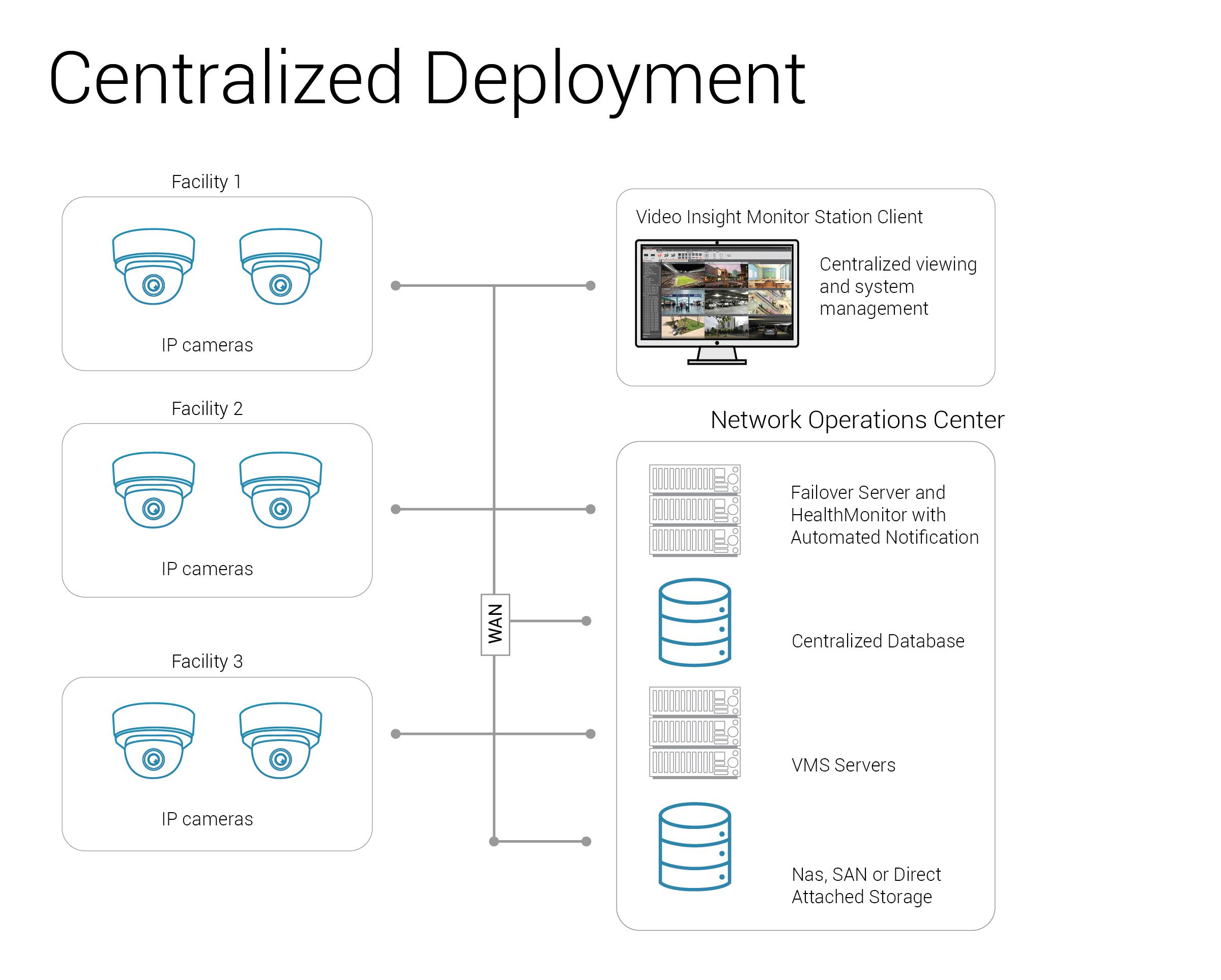

3rd Party Access Control
VI7 also supports integration with a number of industry leading access control manufacturers at no cost.
Integration instructions for 3RD Party Access Control solutions: Click Here



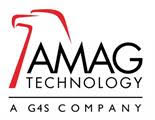












MAXIMIZES SURVEILLANCE SYSTEM UPTIME
VI Health MonitorPLUS monitors system resources via an easy-to-use interface to alert administrators via email of any issues that might affect camera and video recording operations.
NEVER MISS AN INCIDENT AGAIN WITH VI HEALTH MONITORPLUS
The new VI Health MonitorPLUS solution is an on-premise application designed to offer users peace of mind, knowing that all the servers and cameras in their surveillance system are up and running, minimizing the risk of missing important events. VI Health MonitorPLUS provides a complete and easy to use interface featuring real-time monitoring of resources, alerting administrators about any issues that might affect the services, and keeping track of any camera failures and video recording interruptions.
Available only in the United States

Web Browsers
Instant stats available
via any browser

Dashboard
Provide health status and overview of the entire security surveillance system

Email Notifications
Provide instant notification
and real-time alerts

TRACK SERVER AND CAMERA HEALTH AVAILABILITY
Provides detailed information over the health of your site’s cameras along with the CPU, memory, and storage usage of each server being monitored.
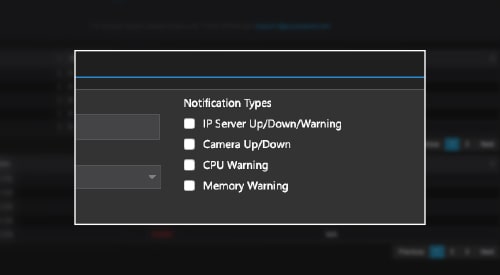
RECEIVE EMAIL NOTIFICATION ALERTS
In the event of downed cameras or unresponsive servers, designated users receive notifications in real-time alerting them of the issue, minimizing downtime.

GENERATE CUSTOMIZABLE REPORTS
Provides the ability to generate transaction reports based on date ranges, allowing users to quickly identify trouble spots.
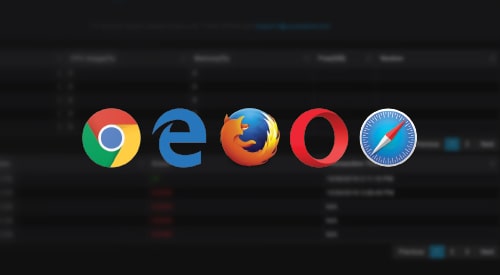
ACCESSIBLE AND INSTANT STATS THROUGH ANY BROWSER
No matter where you are, you can keep tabs on the health and status of multiple sites through any major web browser of your choice.
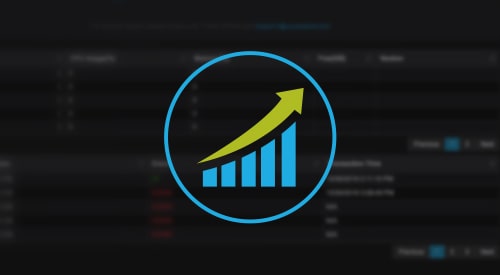
UNLIMITED MONITORING
Due to its unique architecture VI Health MonitorPLUS can grow and scale based on your needs, no matter the configuration.
IP Server Requirements
Minimum specifications depend highly on total camera load placed on each individual server, and total bandwidth availability of network which the cameras reside on. Please consult with an i-PRO sales professional for accurate system requirements based on your site’s needs.
If considering Virtualization, please consult the i-PRO Sales Engineering team, the below recommendations do not apply.
| Component | Minimum | Recommended |
|---|---|---|
| Processor | 1 x 4 Core / 8 Threads | 2 x 8 Core / 16 Thread |
| Memory | 8 GB | 16 GB+ |
| Network | 1 Gb/s+ | 1 Gb/s+ |
| Display Resolution | 1920 x 1080 | 1920 x 1080 or above |
| OS | Win 11 | Win 11 or above |
- Storage
- Failover
- Active Directory
- Load Balancing
- Virtualization
- Software
Development Kit - Administration
- Additional Server
Architecture Info
Storage
The Video Insight Server can write to a single drive, multiple drives, or each camera can be pointed to a unique drive. The Server creates a folder structure that is organized by IP address and date and time. By default, the Server will use all available storage in the designated path and overwrite the oldest video when necessary.
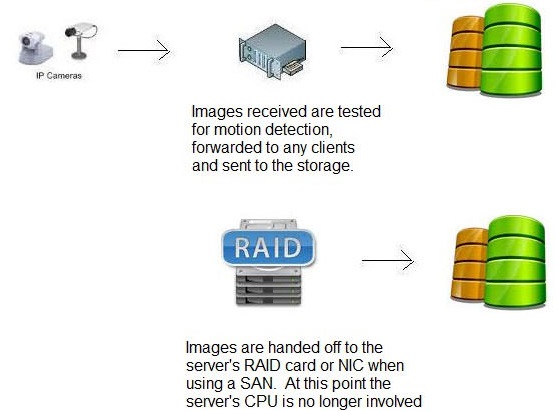
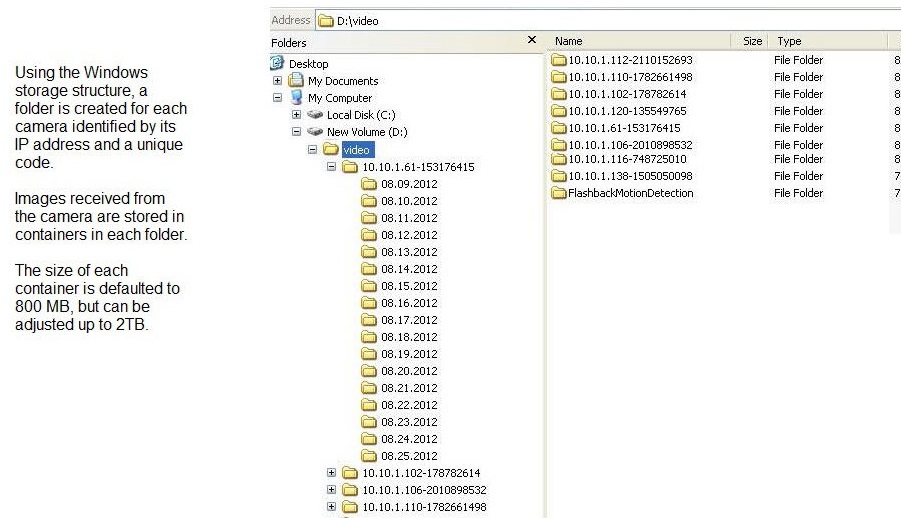
Storage Requirement
The amount of storage is determined by the bitrate of each camera and how much of that will need to be saved. For example, a 1.3 Megapixel camera set at 10 FPS can be configured to stream video at 1.5 Mbits/sec and if the camera is recording motion at 50% of the time, then we can estimate we need 7 GB of storage per day.
Storage Throughput
Video Insight supports all storage that Windows can address. In addition to the size of the storage, it’s necessary to confirm the storage system can handle the amount of video — otherwise video can be lost when the storage is overloaded. To calculate the maximum storage throughput we must assume all cameras will write simultaneously and add up all camera bit-rates. Since most storage systems refer to their maximum simultaneous write speeds in Mbytes, divide the total camera traffic by 8 to convert it to MB. For example, let’s assume you have 100 cameras that will stream at 3Mbits/sec or a total of 300Mbits and we expect them to record 50% of the time. The storage system must be able to write 37.5 MB/sec at its maximum. Video Insight has developed a storage speed test to confirm your systems capability.
Types of Drives
Hard drive manufacturers offer a wide variety of drives, offering different speeds and MTBF rates. When selecting drives, consider that video surveillance applications write data continuously but have far fewer read requests. This differs from typical file server operations where the hard drive is reading and writing simultaneously.
RAID
To provide the maximum protection to your data, we recommend using RAID5 with a designated Hot Spare. RAID5 allows for a single drive to fail without data loss and by designating a Hot Spare, the system will automatically rebuild the RAID on failure. Ensure your RAID card can handle the camera’s traffic as described above and for larger deployments, hardware based RAID with onboard cache is preferred.
Here are Few Performance Examples:
Dell PowerEdge R720xd with (12) 4TB drives providing a usable storage of 36TB The Dell H710 PERC RAID card has a maximum storage throughput of 313.65MB/sec with continuous writing of 115 MB/sec.
Dell PowerEdge R520 with (8) 3TB drives providing a usable storage of 19TB The Dell H710 PERC RAID card has a maximum storage throughput of 313.65MB/sec with continuous writing of 205 MB/sec.
Brands
The Video Insight Server supports all Windows addressable storage. Current customers are using storage solutions from Dell, EMC, HP, Isilon, and others.

Failover
The Video Insight Server supports Automated Failover at no additional software cost. When utilizing the Video Insight Single Database configuration, a physical or virtual server can be designated as a Failover. This server will monitor the other servers and inherit the cameras of a failed device.
For example, if we have the five servers with one designated as a Failover, when one of the four stops writing information to the SQL database, the Failover Server will assume the role of the failed server and all camera traffic will now be associated with that server. Once the failed server is put back into service, restarting the primary server will move the cameras back to their original location.
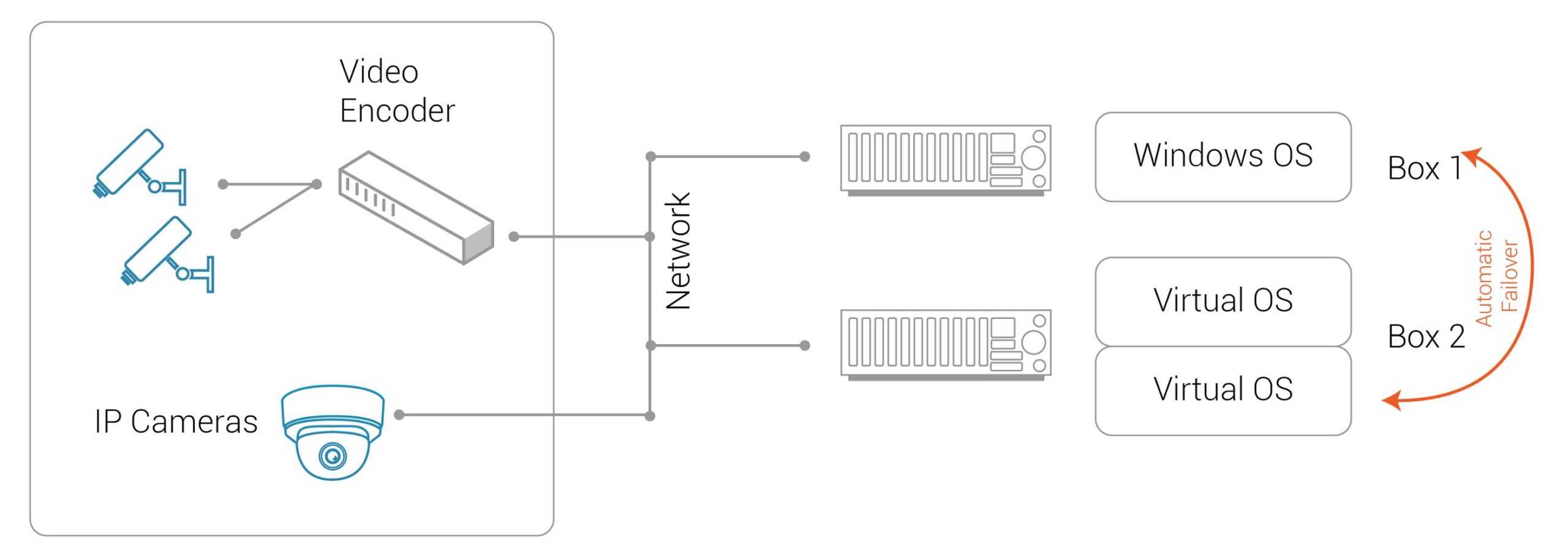
Active Directory
User Management
Video Insight includes a standalone user management system or integration with Active Directory, LDAP, and Novell eDirectory. When using AD or LDAP, administrators create an active connection to the AD Server providing real time authentication.
Features
- Create Individual Users
- Assign Users to Groups
- Assign Granular Permissions for Live, Recorded, Controlling PTZ, PTZ Prioritization, Clip Creation, Viewing Facility Maps, Layouts
- Restrict Administrator Privileges
- Link permissions to AD Users or Groups
- Active integration authenticates each request to the AD Server
- Works across all clients including Monitor Station, Web Client and Mobile
- Single User Management works across multiple servers
- Federated Login option for Monitor Station allows login to unassociated systems
- Supported User Directories
- Video Insight Users and Groups
- Active Directory
- LDAP
- Novell eDirectory
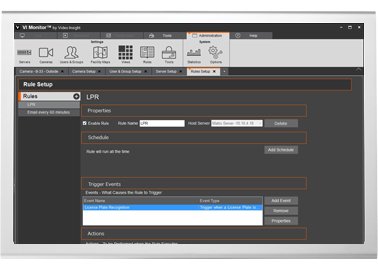
Load Balancing
Video Insight stores all camera-related settings in a Microsoft SQL Server database. In multi-server configurations, a single database can be used to store all settings. Using a centralized database has a number of benefits including automated failover, but it also allows administrators to easily move cameras between servers. For example, let’s assume you have 100 cameras spread across two equally-sized servers, but one of the servers is only keeping 20 days of recorded history instead of the desired 30 days. Using the Camera Setup tab, you can easily move cameras between servers with a few mouse clicks.
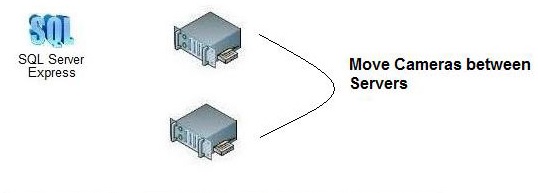

Virtualization
Video Insight supports all virtualization platforms, including VMware, Microsoft Hyper-V, and Citrix XenServer. Virtualizing your surveillance allows you to leverage existing infrastructure as well as create a perfect environment to test and deploy.
Deployed Virtual Environments:
- VMware EXS, EXSi, vSphere Server 5
- Citirix XenServer 6
- Microsoft Hyper-V 2008 and 2012
Benefits:
- Maximize server hardware
- Quick Deployment of Video Insight Servers
- Multiple virtual OSes can share memory and CPU
- Virtual load balancing and failover
- Leverage existing server hardware like blade servers
- Easy backup and maintenance with snapshots
- Add existing storage
- Combine storage from multiple hosts into one logical shared drive
- Create VM’s for each campus
- Easy migration between hardware
- Easy hardware migration as system expands
- Create a Video Insight template for rapid deployment
- Transparent to the users
Software Development Kit
The Video Insight Software Development Kit (SDK) is application programming interfaces that provides the ability for third-party software developers to access capabilities like live and playback video from Video Insight IP servers.
SDK Details
- The SDK application programming interface is supported by Video Insight. There are two types of SDKs supported by Video Insight. The restful API, Insight API, is used by our new web client, and the plug-in SDK is used by the VI LPR and thermal plug-in of VI MonitorPlus.
- This support guarantees the developer that the interface is used by our main product lines. As new cameras, compression types and functionality are added to our main product line, these SDKs will be updated in a manner that the existing code will be functional with new server features.
- Wide camera library: Video Insight supports over 4,300 cameras from 145 manufacturers.
- Add video: These SDKs make it easy to add video functionality to security systems, all in a basic understanding of programing.
- For developers, the SDK is available free of charge.
- SDK support is available. For more details on VI SDK program, contact us.
SDK Supports a Set of Functions Highlighted Below
- Retrieve resource information regarding Video Insight IP server, such as a list of servers and cameras, by proper permission management, and the live, playback, and PTZ can be done.
- Show live video in a 3rd-party client or in the VI MonitorPlus.
- Look up a camera’s recorded videos or play recorded video in a 3rd-party client or in the VI MonitorPlus. The playback is controlled by developed application.
- Video clip export is also available.
- Control pan-tilt-zoom operation to PTZ cameras and recall presets if available.
- The Insight API can send defined events to trigger the rules manager, which allow it to make any action such as sending camera view, pop-up live, etc.
- The plug-in SDK can receive an event created by the Insight API so that a unique application can be developed easily.
Administration
The Monitor Station client is used to configure and administer Server settings. In addition, the Monitor Station provides administrators a robust set of tools to optimize server performance including bit rates, last image received, FPS, and resolution.
Video Insight Server and Clients are upgraded with a single Setup.exe. Updates do not require existing applications to be removed, and includes automated update distribution.
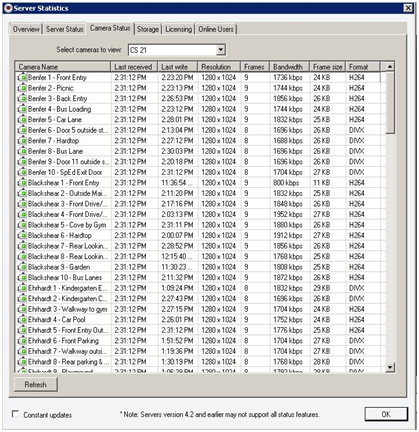
SQL Database
Video Insight uses a Microsoft SQL Server database to store system settings, user permissions, activity, alarm, and system logs. Video is not stored in the SQL Database so the database can be installed locally on the server and multiple servers can utilize one database. In addition, the SQL Database can be installed in a central location for multiple systems to share. When using the Monitor Station users do not see a difference when using a single or multi-database configuration. Microsoft SQL Server Express is installed during the standard installation of Video Insight. For installations that have existing SQL Servers already running, the Video Insight Servers can utilize a single database providing additional redundancy of the database.
Benefits of a Single Database Configuration When Using Multiple Servers
- Central Administration
- Simplified User and Group Management
- Automated Failover
- Load Balancing
Tpyical Size of a Database
- 20 Cameras – 10 MB
- 200 Cameras – 500MB
- 500 Cameras – 1 GB
- 1,000 Cameras – 2 GB
- 5,000 Cameras – 10 GB
The database size will vary based on the amount of motion alarms. In environments with higher motion activity, the actual size of the database could be larger.
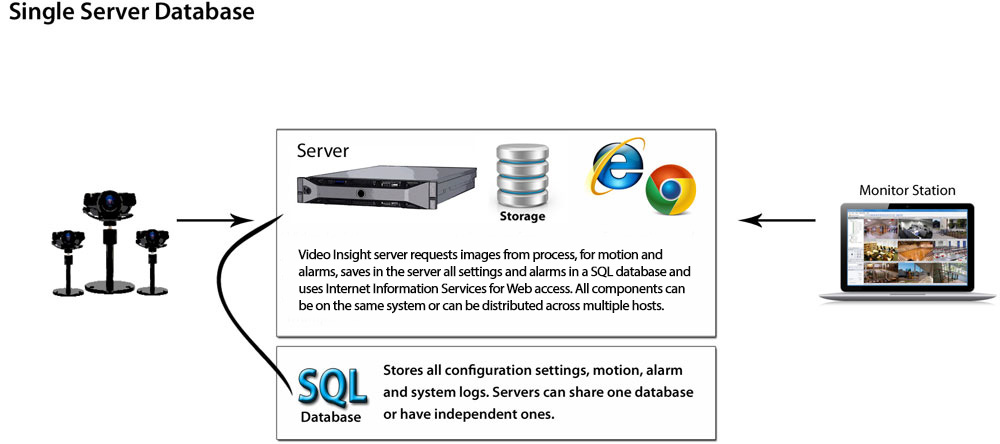

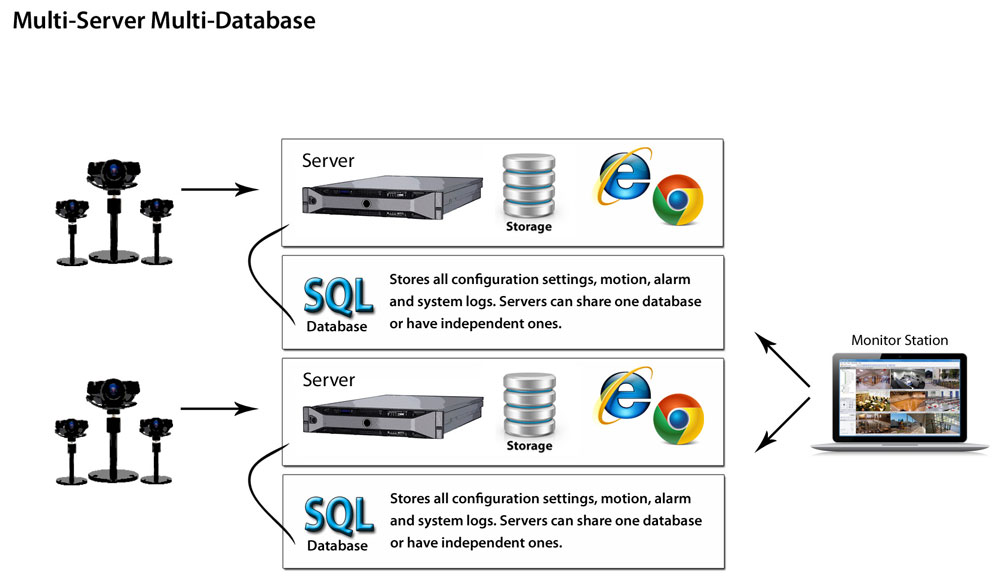
IIS
Video Insight utilizes Microsoft Internet Information Services (IIS) to power the Web Client. IIS is installed as a component of Windows and simply needs to be enabled for most OS versions. Each Video Insight Server will utilize IIS on the local server, and with the use of a shared database, can power the Web Client for use with any server load-balancing. Administrators can point users to a single URL address and the Video Insight Server with IIS will pull the live and recorded video from the appropriate server. For load balancing purposes, groups of users can be pointed to different Video Insight Servers. This decreases the amount of inter-server traffic.
Specifications
Video Insight supports all of the IIS versions of the supported Operating Systems.
Performance Metrics
The Video Insight Web Client supports two transmission methods referred to as Low and High Speed mode. When using Low Speed mode, the Web Client receives MJPEG images and when in High Speed mode, the client receives the camera’s native compression. IIS handles the transmission and its process is not CPU intensive.
When considering the number of Web Client users per server, the most important consideration is the cumulative bandwidth required.
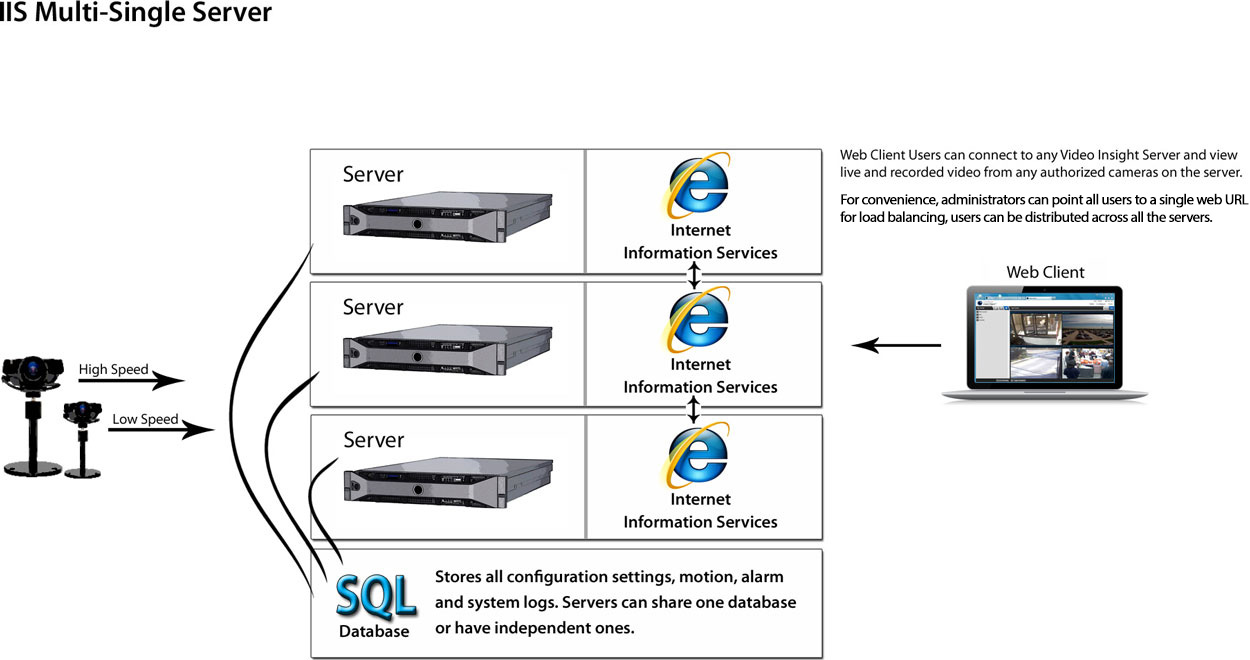
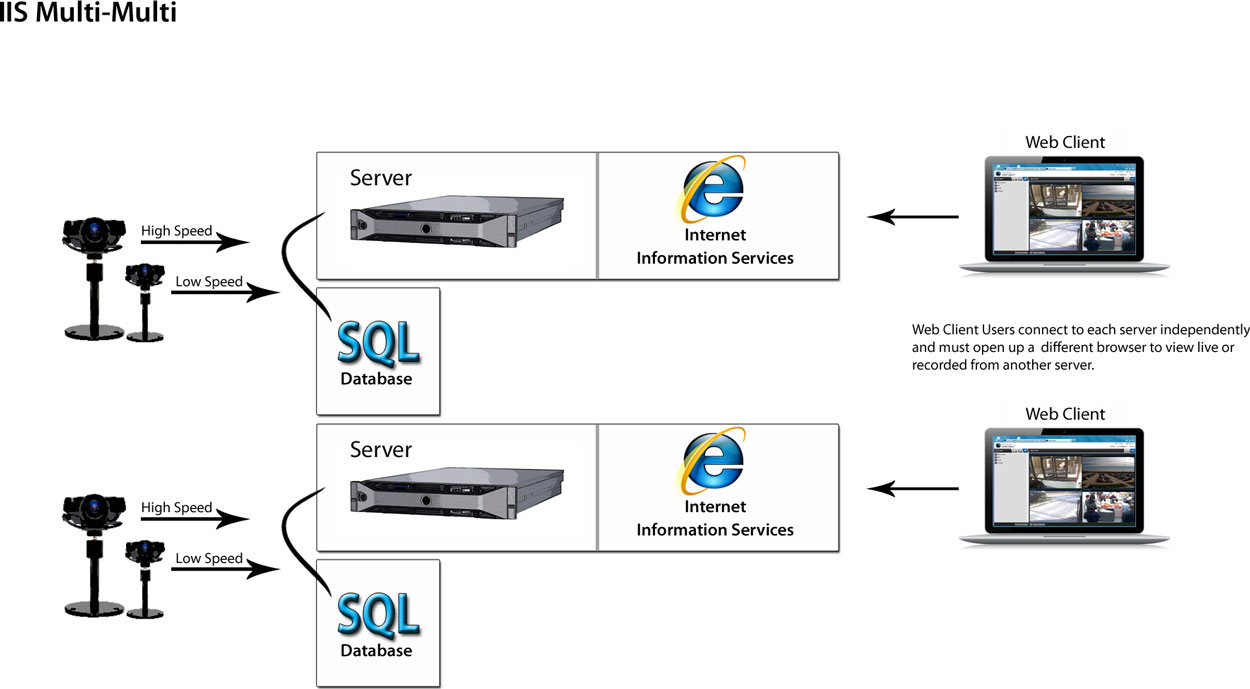
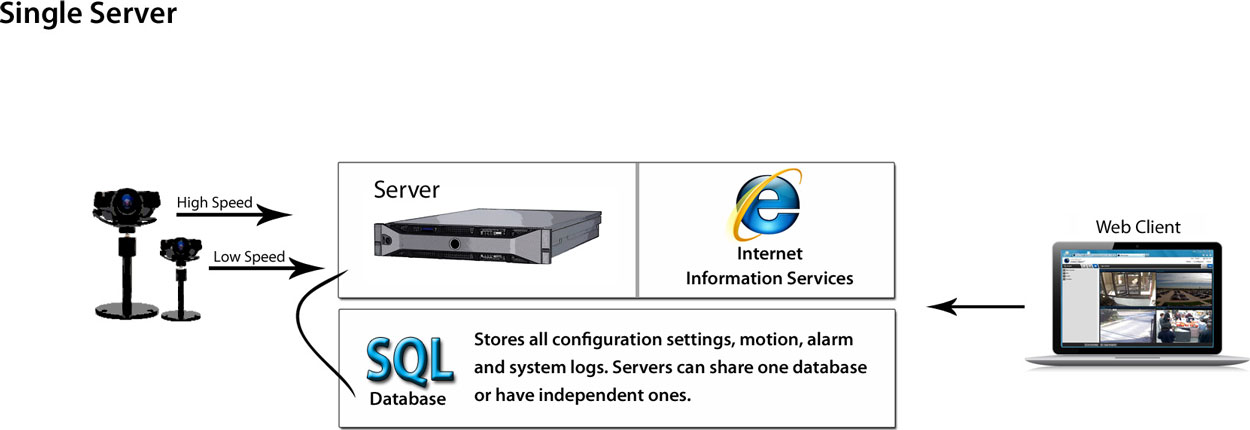
Centralized
Video Insight supports distributed and centralized deployments. As an example, let’s use a school district that has 25 campuses. Traditionally, this required each campus to have servers, requiring space, power, security, and air conditioning. With increases in bandwidth, switching, and better compression, it’s now possible to move the servers to a central data center.
Benefits include:
- Reduced capital investment
- Increased camera count per server with up to 200 cameras per OS
- Take advantage of virtualization and blade servers
- Optimized storage
- Reduced power and environmental requirements
- Reduced maintenance costs
- Robust Redundancy with Automated Failover
- Leverage existing technology infrastructure, personnel and bandwidth
Centralization can also mean centralizing existing DVRs and NVRs into a single solution. For example, a high school might have 10 DVRs spread across the campus. Using solid-state video encoders, all the video can be sent to a single NVR.
Centralization can be very beneficial, but the following areas need to be addressed prior to deployment:
- Will the network bandwidth support the IP camera traffic?
- How redundant is the network?
- Can we use SD cards for onboard storage?
Centralized References
- Denver Public Schools
- 2,500 cameras
- 155 campuses
- Cisco USC Server with 500TB of EMC Storage
- 30 Win 2008 OS on 4 blades
- Decentralized Servers $1.5M, centralized $500,000
- Added additional cameras with savings
- Klein ISD, Texas
- 1,550 1.3MP Acti Cameras
- 13 HP Servers
- 120TB Storage
- 50 Virtual OS on VMware 5
- Centralized configuration
- AD integration
- Direct Attached Storage
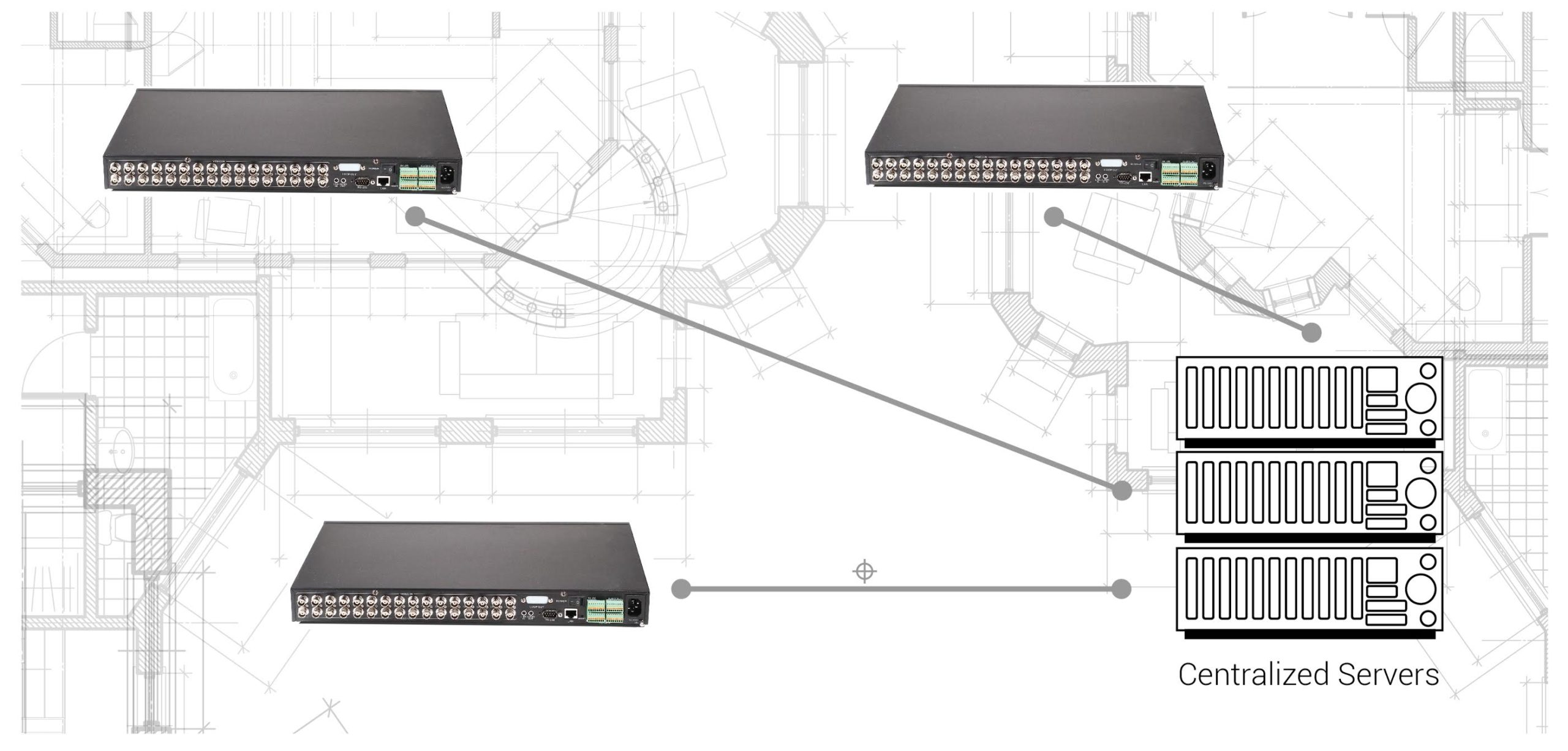
Network
The Video Insight Server can support multiple network interface cards (NIC) and traffic can be segmented by type. A common configuration is to isolate camera traffic on one NIC and connect a second NIC to the corporate network. This isolates all camera traffic, ensuring it does not affect normal traffic. In addition, the Server can support camera traffic from multiple NICs.
When using the Web Client, IIS handles all internal routing and can support inbound traffic on all NICs, but the server listens for the Monitor Station on a single NIC.
Analytics
As processing power increases, camera manufacturers are adding more features to cameras. In addition to H.264 compression and enhanced onboard motion detection, analytics, like directional direction and enter and exit filters, are becoming common. These analytics allow rules to be configured to do object counting or alarms when a vehicle enters an unauthorized area. The Video Insight Server accepts these inputs and allows users to set up automations based on their trigger. For example, the following uses a counting analytic to notify the operator if the number of people in a room exceeds the specified threshold.
Video Insight supports camera-side analytics from the following manufacturers:
- Axis
- Sony
- Hikivision
- Pelco
- Advidia
- 2N
- Canon
- Dante
- DigiOp Black
- Infinova
- Samsung
- SightLogix
- UDP
These companies have a variety of analytics including:
- Advanced Motion Detection
- Crosswire Detection
- Directional Detection
- Defocus Detection
- Smart Face Detection
- Audio Exception Detection
- Intrusion Detection
- Tamper Detection
- Face Detection
- Face Recognition
- Scene Change Detection
- People Counting
- Direction, Stopping, Dwell filter
- Enter and Exit filters
- Appear and Disappear filters
- Speed filter
- Tailgating
- Includes non-detection zones
We can setup scheduled based Rules, that on alarm, can do any (or multiple) of the following:
- Alarm Log
- Alarm Window
- Audible alert
- Digital Output
- Text Message
- Email with AVI
- Email with JPEG
- Email Snapshot
- Execute a Program
- File Manipulation
- HTTP Command
- Instant Replay
- Live pop-ups
- Instructions
- Decoders
- Move PTZ
- Change Recording
- Switch Audio
- Switch Camera
- Change Layouts
- TCP Message
- Time Lapse
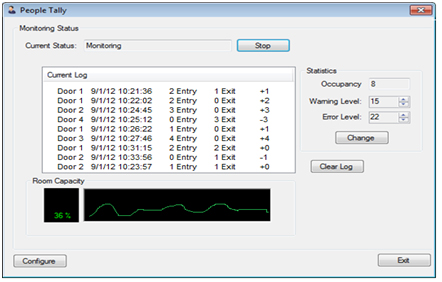
Hosting
Bandwidth is the primary challenge associated with hosted video, but the second challenge is the backend server. Most VMS platforms specify 120 or fewer cameras per server. In a hosted environment, this server requirement can dramatically increase the deployment costs. Video Insight v5.5 has been designed for Hosted Video with single OS support at over 2,000 cameras per host.
Features
- No limit hosting
- 3,000 camera models from 100 manufacturers
- Distributed load balanced
- Automated Failover
- Robust Web Client
- iOS and Android Mobile Clients
Call us for a more detailed overview of our hosting offering.